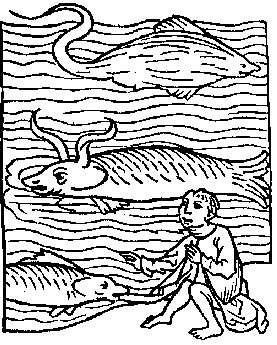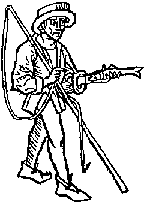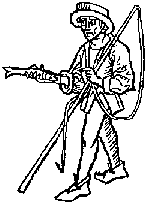

|
|
 FANTASTIC FISH TABLE OF CONTENTS SEE ALSO: Jeanne La pucelle and the Dying God Medieval Woodcuts Clipart Collection Mythical Plants of the Middle Ages
PLEASE VISIT: The Gode
Cookery Bookshop |
"The noble lyfe & nature of man, Of bestes, serpentys, fowles & fisshes y be moste knowen"  A late-medieval manuscript translated into modern English, with period illustrations.
Here are the fantastic and
incredible fish of the Middle
Ages, which
populated both the waters and the imagination of the medieval world.
Real
creatures still familar to us, such as the salmon and the crayfish will
be found here, but you will also read of such fabulous specimens as the
Abremon,
which propagated without intercourse, the Ezox, so large that a
four-horsed cart could not carry one away, and the Nereydes,
sea
monsters that cried whenever one of them died.
Fantastic Fish of the Middle
Ages is from Lawrens Andrewe's "The
noble lyfe & nature of man, Of bestes, serpentys, fowles &
fisshes
y be moste knowen" as reprinted in The Boke of Nurture by
Frederick
J. Furnivall, 1894. Andrewe's original work was printed sometime
between
1400 & 1550.
The modern English
translations of Andrewe's text are by
James L.
Matterer.
The illustrations come from
two Dover Books: Curious
Woodcuts
of Fanciful and Real Beasts & Medieval Life Illustrations.
And now here is Lawrens Andrewe's "The noble lyfe & nature of man, Of bestes, serpentys, fowles & fisshes y be moste knowen" as reprinted in Frederick J. Furnivall's 1894 edition of The Boke of Nurture: Extracts about fish from "A very rare black-letter
book, without date, and hitherto
undescribed,
except perhaps incorrectly by Ames (vol. 1, p. 412, and vol. 3, p.
1531),
has been lent to me by Mr. Algernon Swinburne. Its title is given
above:
'The noble lyfe and natures of man' is in large red letters, and
the rest in smaller black ones, all surrounded by woodcuts of the
wonderul
animals, mermaids, serpents, birds, quadrupeds with men's and women's
heads,
a stork with its neck tied in a knot, and each other beatss 'y be
most
knowen.' The illustrations to each chapter are wonderfully quaint.
The author of it says in his Prologus:
'In the name of ower
sauiour criste Iesu, maker &
redemour
of al mankynd, I Lawrens Andrewe of the towne of Calis haue translated
for Johannes does-borrowe, booke prenter in the cite of Andwarpe, this
present volume deuyded in thre partes, which were neuer before in no
maternall
langage prentyd tyl now .'
As it is doubtful whether
another copy of the book is
known, I extract
from from the Third Part of this incomplete one such notices of the
fish
mentioned by Russell or Wynkyn de Worde, as it contains, with a few
others
for curiousity's sake."
Frederick J. Furnivall, 1894.
Here after followeth of the natures of the fisshes of the See whiche be right profitable to be vnderstande. Wherof I wyll wryte be the helpe and grace of almighty god, to whose laude & prayse this mater ensueth. - Lawrens Andrewe Page One:
Visit our companion site
Our Favorite Letter! Subject:
fish Date: Mon, 26 Jun 2000 From: Simon Lachance
Do you
not know that some while do sing when one of them
die you
say that like if it where some sort of strange thing that does not
happen
in nature. And yes there are anamils that "propaget without
intercourse,
and about the Ezox try to lift or even move one with "a four-horsed
cart"
and then you a bulldoures so to say that this creatures do not live is
very fool-hearted of you!!!!!!!!!!!!!!!!!!!!!!!!!!!!
Thanks! ...I think....
Recommended: Curious Woodcuts of Fanciful and Real Beasts: A Selection of 19O Sixteenth-Century Woodcuts from Gesner's and Topsell's Natural Histories by Conrad Gesner, Konrad Gesner, Edmund V., Jr. Gillon (Editor) 
Looking for a specific recipe, food, or ingredient at Gode
Cookery?
Gourmet medieval & Renaissance cookies from Gode
Cookery, perfect
for feasts, weddings, receptions, & more. In dozens of delightful
&
authentic designs.
http://www.godecookery.com/cookies/cookies.html
|



 Fantastic
Fish of
the Middle Ages
Fantastic
Fish of
the Middle Ages
 Gode Cookery
Gode Cookery